UPS systems - an important partner for the future of renewable energy
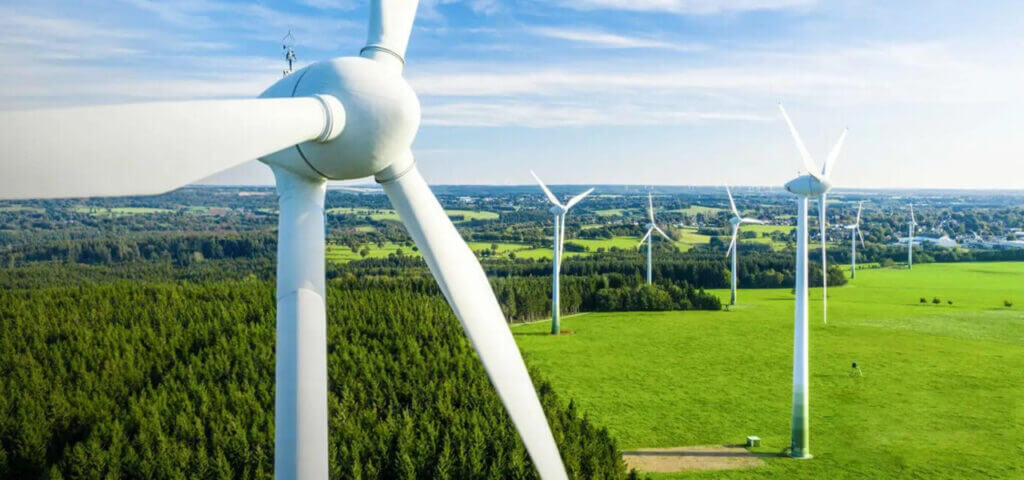
It's an explosive mix - rising global temperatures, rising global energy demand and electricity consumption and, last but not least, the switch to renewable energies for power generation. It is clear that we will not be able to break the vicious circle without this switch, but we are also taking a high risk: To meet the increased energy requirements of data centers, IoT (Internet of Things), electromobility and much more, we need more and more electricity and at the same time a high level of reliability and stability of the power supply.
Renewable energies vs. stable power supply
However, it is precisely renewable energies that do not provide a stable and continuous power supply. Wind and solar power plants feed energy into the grid depending on the weather - unlike large power plants, which generate electricity according to demand. This makes it all the more difficult for grid operators to maintain a balance between generation and consumption. If the frequency in the grid falls or rises too sharply, this affects the function of numerous electrical devices - in the worst case scenario, the grid could collapse.
Ever-increasing energy demand and ever-increasing uncertainty in terms of security of supply and stability appear to be an irresolvable contradiction. Not only will energy demand increase many times over in the coming years, but the proportion of renewable energies in the electricity mix will also rise - to at least 80 % by 2050 according to the Renewable Energy Sources Act (EEG). If we want to stop climate change, this is certainly a necessary measure. However, this will make it all the more difficult to ensure an uninterrupted, constant power supply. Grid operators are therefore currently working at full speed to equip the electricity grid with smart control technologies. But something also needs to change on the consumer side.
Uninterruptible power supply (UPS) in the context of climate change
Data centers, edge technology, industrial facilities and the expansion of the 5G mobile network require a lot of electricity and a high level of reliability at the same time. According to Borderstep, data centers in Germany consumed 13.2 billion kWh of electricity in 2017. Cooling and the uninterruptible power supply (UPS) alone accounted for 5.3 billion kWh. Reliability with the help of UPS will become increasingly important in the future due to the increasing feed-in of renewable energies and the associated fluctuations in the power grid. Even a failure lasting just a few milliseconds can cause major damage in a data center. The use of UPS systems is therefore absolutely essential. But not all UPS systems are the same. Particularly in the context of climate change and from the point of view of energy saving, there are major differences between conventional, monolithic and new, modular UPS systems.
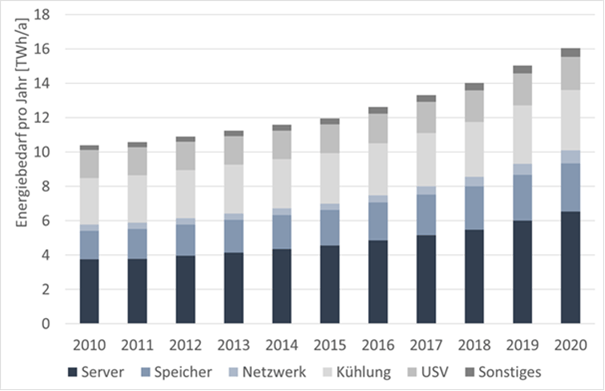
Old UPS systems are designed for peak loads including redundancies and are therefore usually oversized, whereas new systems are modular and can be expanded as required. Another advantage of modular UPS systems is their higher efficiency, as the power loss is around 60 percent lower. Modular UPS systems always operate close to full load and therefore at the optimum. Modern systems also have a so-called Hibernation modewhich puts individual modules into standby when required. This in turn increases the efficiency even further.
An old UPS system with a rated output of 300kVA and an efficiency of 92.5 % consumes almost 89,000 kWh of electricity over a year. In comparison, a comparable modular UPS system with a rated output of 200kVA and an efficiency of 97 % consumes only 34,000 kWh - a saving of around 60 %. If we assume that no modular UPS systems would be in use in German data centers, this would result in potential savings of around 3.2 billion kWh of electricity. This would correspond to a reduction in CO₂ emissions of 1.5 million tons. The savings potential is immense if you consider all companies that rely on a UPS system and where a monolithic system is still in operation. Modern UPS systems can therefore make a major contribution to reducing CO₂ emissions.
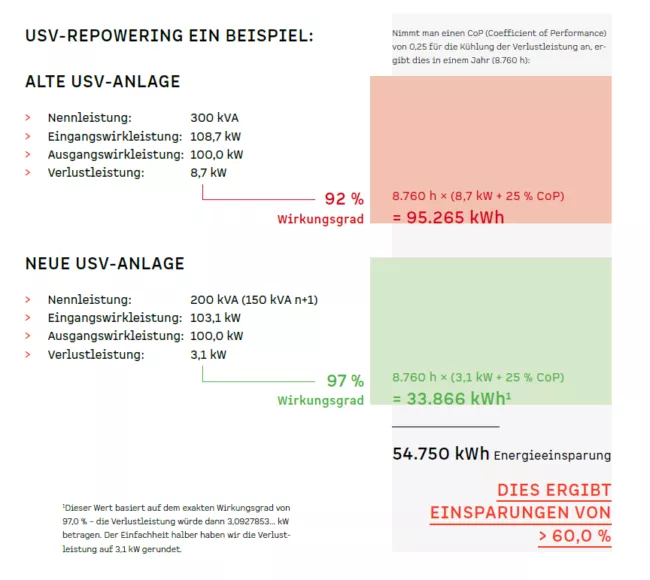
Repowering for more climate friendliness
As already mentioned, many old UPS systems are still in operation and not every operator will immediately switch to the new UPS systems due to the savings potential. A new purchase always means a high investment, which is often shied away from. However, if you consider the savings potential, the high investment is amortized after a short time. This procedure is already familiar from the renewable energy sector under the term repowering. For example, old wind turbines are replaced with new, more powerful turbines and the investment costs are recouped after a short time due to the higher output. This phenomenon also applies to UPS systems. The investment costs of a modern UPS system with a rated output of 200kVA are amortized after just five years thanks to the annual electricity cost savings of around EUR 8,000.
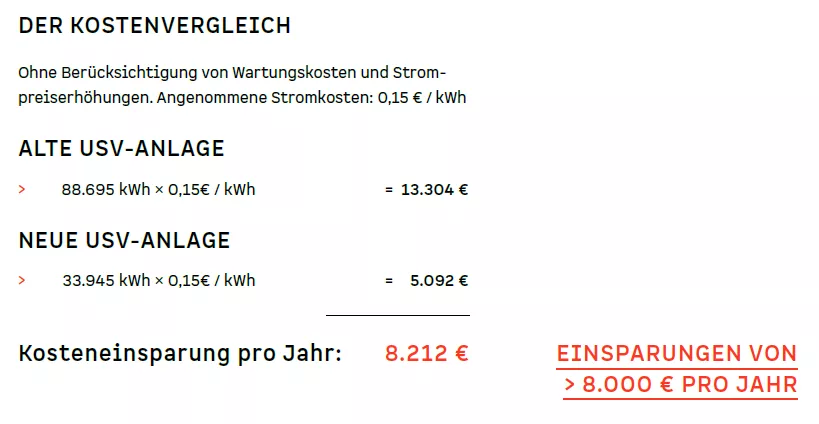
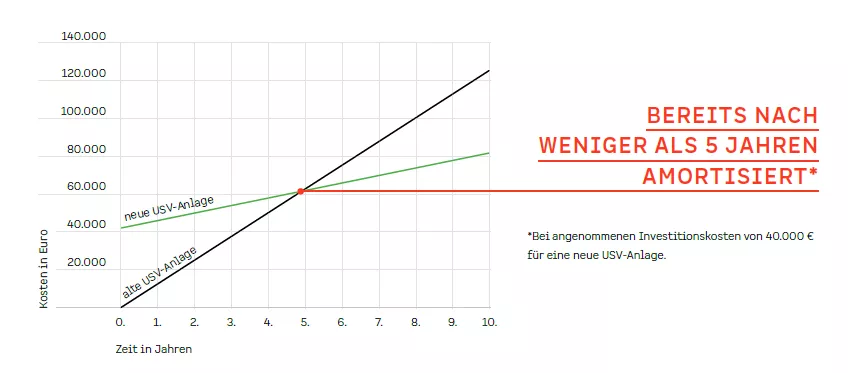
You can calculate your individual savings with our energy savings calculator.
Why companies should switch to modern UPS systems now
There is no question that we are in the midst of unprecedented climate change. The ambitious targets to halt this climate change can only be achieved through a rapid switch to renewable energies. However, it is not just politicians who are called upon to do their bit; business must also play its part. In recent years, many companies, including 500 companies in the electrical industry, for example, have signed a Code of Conduct, which includes commitments to environmental protection and sustainability. The use of a modern, modular UPS system would be an important step towards greater climate protection. In addition to the climate policy aspect, the use of such a system would also bring companies other benefits:
- Scalability
- High cost savings
- Higher efficiencies
- Zero downtime
- Remote monitoring
- Longer battery life
Switching to or installing a modern UPS system therefore not only improves the environmental balance, but also the accounting balance and is recommended for every company.
